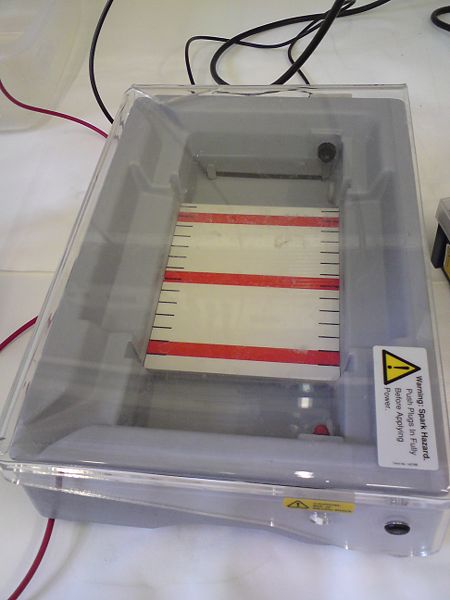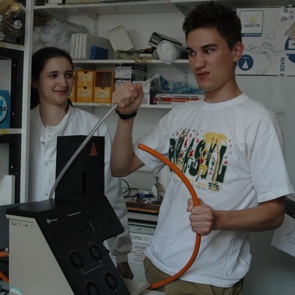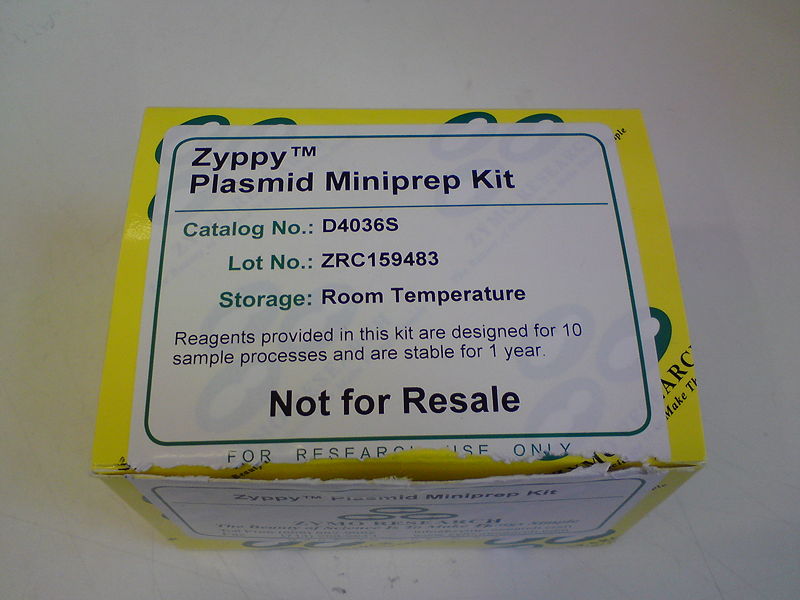Team:Cambridge/Protocols
From 2008.igem.org
(New page: <hr width="810px"> <div id="about"> {{Cambridge08a}} </div> <hr width="810px"> =Agarose Gel= Agarose gel Used for Electrophoresis when extracting ...) |
|||
| (9 intermediate revisions not shown) | |||
| Line 1: | Line 1: | ||
| - | < | + | {{Cambridge/Notitle}} |
| - | < | + | <div class=bodytable> |
| - | + | {{Cambridge08}} | |
| - | </div> | + | {{Cambridge08protocol}} |
| - | < | + | <html> |
| + | <table style="background:#444444; padding:15px;"> | ||
| + | <table align=left width= border="0" style="background:#444444; padding:5px;"> | ||
| + | <tr> | ||
| + | <td style="width:100%; height: 400; padding-left: 15px;"> | ||
| + | <b class="b1f"></b><b class="b2f"></b><b class="b3f"></b><b | ||
| + | class="b4f"></b> | ||
| + | <div class="contentf"> | ||
| + | <div style="height: 400; background: white; line-height:170% padding: | ||
| + | 5px;"> | ||
| + | <div style="color: white; font: 2px;">x</div> | ||
| + | </html> | ||
=Agarose Gel= | =Agarose Gel= | ||
| - | [[Image: | + | [[Image:Protocol01.JPG|right|thumb|190px|Agarose gel]] |
Used for Electrophoresis when extracting any product afterwards. | Used for Electrophoresis when extracting any product afterwards. | ||
| Line 69: | Line 80: | ||
=E-Gel= | =E-Gel= | ||
| - | [[Image: | + | [[Image:Protocol02.JPG|right|thumb|150px|Our E-gel machine from invitrogen]] |
E-Gel is used to confirm size of products, but not for extraction. | E-Gel is used to confirm size of products, but not for extraction. | ||
| Line 126: | Line 137: | ||
=Flame Photometry= | =Flame Photometry= | ||
| - | [[Image: | + | [[Image:Protocol03.jpg|20px|frame|right|Chris attempts to unravel the secrets of the Flame Photometer]] |
'''Set Up''' | '''Set Up''' | ||
:*Make sure discharge pipe (on right hand side) is placed in something to collect discharge, and valve is not completely shut. | :*Make sure discharge pipe (on right hand side) is placed in something to collect discharge, and valve is not completely shut. | ||
| Line 239: | Line 250: | ||
=Plasmid Miniprep (Zyppy)= | =Plasmid Miniprep (Zyppy)= | ||
| - | [[Image: | + | [[Image:Protocol04.JPG|right|thumb|240px|Plasmid Miniprep kit]] |
:*Add 100μL 7x Lysis Buffer to 600μL Cell Culture. Invert 4 to 6 times | :*Add 100μL 7x Lysis Buffer to 600μL Cell Culture. Invert 4 to 6 times | ||
:*Add 350μL cold Neutralization Buffer. Invert 4 to 6 times | :*Add 350μL cold Neutralization Buffer. Invert 4 to 6 times | ||
| Line 255: | Line 266: | ||
=PCR= | =PCR= | ||
| - | [[Image: | + | [[Image:Protocol05.jpg|thumb|220px|right|Our Piko PCR machine provided by Finnzymes]] |
To make 50μL of PCR mix the following were added to Eppendorf tubes: | To make 50μL of PCR mix the following were added to Eppendorf tubes: | ||
| Line 280: | Line 291: | ||
=''E.coli'' transformation= | =''E.coli'' transformation= | ||
| - | [[Image: | + | [[Image:Protocol06.JPG|230px|right|thumb|Plates with transformed cells]] |
First chemically competent cells are made | First chemically competent cells are made | ||
:*Cells are grown for 1-2 hours in LB and pelleted (at 4000rpm for 8 min.) | :*Cells are grown for 1-2 hours in LB and pelleted (at 4000rpm for 8 min.) | ||
| Line 324: | Line 335: | ||
Elution efficiency is dependent on pH. The maximum elution efficiency is achieved between pH 7.0 and 8.5. When using water, make sure that the pH value is within this range, and store DNA at –20°C as DNA may degrade in the absence of a buffering agent. The purified DNA can also be eluted in TE (10 mM Tris·Cl, 1 mM EDTA, pH 8.0), but the EDTA may inhibit subsequent enzymatic reactions. | Elution efficiency is dependent on pH. The maximum elution efficiency is achieved between pH 7.0 and 8.5. When using water, make sure that the pH value is within this range, and store DNA at –20°C as DNA may degrade in the absence of a buffering agent. The purified DNA can also be eluted in TE (10 mM Tris·Cl, 1 mM EDTA, pH 8.0), but the EDTA may inhibit subsequent enzymatic reactions. | ||
| - | =''Bacillus | + | =''Bacillus subtilis'' Transformation= |
| - | [[ | + | Transformation Procotols for ''B. subtilis'' can be found here: [[Team:Cambridge/Bacillus subtilis transformation| ''Bacillus subtilis'' Transformation Protocols]] |
| + | |||
| + | <html> | ||
| + | <div style="color: white; font: 2px;">x</div> | ||
| + | </div></div> | ||
| + | <b class="b4f"></b><b class="b3f"></b><b class="b2f"></b><b | ||
| + | class="b1f"></b> | ||
| + | </td></tr></table></table> | ||
| + | </html> | ||
Latest revision as of 20:12, 29 October 2008
|
x
Agarose GelUsed for Electrophoresis when extracting any product afterwards. Making the Gel
Loading the Gel
Running the Gel
Visualising the Gel
Biobrick ExtractionLink to list of extracted parts We found we could not extract enough DNA from the registry, so we are upgrading the extraction to the "bigger, better, faster, stronger" method.
We then confirmed with PCR. Competent Cells StocksChemically competent cells are made by growing overnight in 200ml LB in a shaking incubator at 37°C. 200ml are spun down at 3800rpm for 8 mins, resuspended in 20ml CaCl2, spun down again and resuspended in 4ml CaCl2. Again spun down (6500 rpm for 5 mins)and resuspended in 4ml 60%glycerol, spun down and resuspended in 2ml 60%glycerol. Finally they are aliquoted (100μL) into stock tubes and flash frozen in liquid nitrogen. To recover cells thaw the tubes on ice, spin down and resucpend in 100μL ice cold CaCl2. Electroporation competent TOP10 and DH5α cells were made by growing overnight in 200ml LB in a shaking incubater at 37°C. 100ml were spun down at 3800rpm for 8 mins, resuspended in 25ml SDW, spun down again and resuspended in 2ml SDW. Again they were spun down (6500 rpm for 5 mins)and resuspended in 2ml 60%glycerol, spun down and resuspended in 2ml 60%glycerol. Finally they were aliquoted (100μL) into stock tubes and flash frozen in liquid nitrogen. To recover cells thaw the tubes on ice, spin down and resucpend in 100μL ice cold SDW. Dephosphorylation
E-GelE-Gel is used to confirm size of products, but not for extraction.
Fast DigestionThe following are added to a 1.5μL eppendorf:
If using PCR product the whole is made up to 30μL, using 10μL DNA and 3μL buffer. The tubes are then incubated at 37°C for 5mins and then the enzyme inactivated at 80°C for 15mins Fast LigationTo calculate the amount of insert you need, use the equation: 2CB/AD
The result will be the volume of insert you should add to achieve a 2:1 molar ratio of insert to backbone.
The tubes are then incubated at room temperature for 5mins and then the enzyme inactivated at 75°C for 15mins We have now got a different fast ligation kit. Now the following are added to a 1.5μL eppendorf:
The tubes are then incubated at room temperature for 5mins. Flame PhotometrySet Up
Taking readings
In case of compressor blow-out
In case of wildly fluctuating "zero" readings
Gel DNA Recovery (Zymoclean)
Glycerol Stock (Modified Version)
Media PreparationNOK 2.0 (No potassium nutrient broth)Measure out:
Add to 1dm3 (1l) of SDW and shake well. Note heating 40-50°C may be necessary to achieve full dissolution of solutes. There may be a small amount of indeterminate crud remaining at the end of this process; this is entirely normal and can be ignored. This mixture should then be filter sterilised into 50ml separate tubes (reduces contamination risk of whole batch). Keep refrigerated or frozen until needed. NOK Amino Acid Powder composition This is a solid homogenized mixture of all solid amino acids (except possible GluR0 channel agonists alanine, threonine, serine, glycine, glutamine & glutamate.) Current batch is stored at room temperature on the chemical shelf near the gel area. To make a new batch, measure out 0.5g of each of the following (L-forms ONLY):
Bacillus media10X Medium A base:
10X Bacillus salts:
Medium A
Medium B
Oxygen ElectrodeFor the protocol see http://www.rankbrothers.co.uk/download/digioxy.pdf Plasmid Miniprep (Zyppy)
Primer Preparation and StorageSigma Primers arrived as tubes of dried oligos
PCRTo make 50μL of PCR mix the following were added to Eppendorf tubes:
These values can be adjusted for any volumes of final mixture. The total final volume is transferred to thin walled tubes (may need to be spun down) and then placed in a PCR machine and the appropriate program run. When using primers designed to produce longer product than original gene touchdown cycles should be run with annealing at the initial binding Tm and then normal cycles at the full length Tm. Making your own 4x Master MixPer 20μl Reaction, Add in this order:
E.coli transformationFirst chemically competent cells are made
To transform cells
After transformation cells need to be grown under selection conditions. Qiagen QIAquick PCR Purification Kit(from Qiagen QIAquickspin Handbook) This protocol is designed to purify single- or double-stranded DNA fragments from PCR and other enzymatic reactions (see page 8). For cleanup of other enzymatic reactions, follow the protocol as described for PCR samples or use the new MinElute Reaction Cleanup Kit. Fragments ranging from 100 bp to 10 kb are purified from primers, nucleotides, polymerases, and salts using QIAquick spin columns in a microcentrifuge. Notes:
tabletop microcentrifuge.
Elution efficiency is dependent on pH. The maximum elution efficiency is achieved between pH 7.0 and 8.5. When using water, make sure that the pH value is within this range, and store DNA at –20°C as DNA may degrade in the absence of a buffering agent. The purified DNA can also be eluted in TE (10 mM Tris·Cl, 1 mM EDTA, pH 8.0), but the EDTA may inhibit subsequent enzymatic reactions. Bacillus subtilis TransformationTransformation Procotols for B. subtilis can be found here: Bacillus subtilis Transformation Protocols x
|
 "
"





